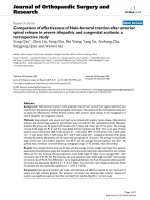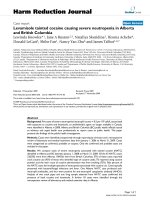SEVERE CONGENITAL NEUTROPENIA
Bạn đang xem bản rút gọn của tài liệu. Xem và tải ngay bản đầy đủ của tài liệu tại đây (123.35 KB, 13 trang )
Granulocyte-macrophage colonystimulating factors (G-CSF) Treatment
for Severe Congenital Neutropenia
(SCN)
Introduction
• Definitions
- Neutropenia absolute neutrophil count (ANC) <1500/microL
- Leukopenia refers to a low WBC that may be due to
lymphopenia as well as neutropenia
- Granulocytopenia refers to a reduced number of
granulocytes (neutrophils, eosinophils, and basophils).
- Agranulocytosis: the absence of granulocytes, but the term
is often used to indicate severe neutropenia (ANC
<200/microL).
Introduction
- Congenital neutropenia
Any neutropenia present at or near birth, would include
transient immune neutropenias as well as inherited causes.
Introduction
Diseases or syndromes of congenital neutropenia
SEVERE CONGENITAL NEUTROPENIA
• The availability of G-CSF (filgrastim,
lenograstim) therapy has dramatically
changed management, resulting in a
significant reduction in infections and
improvement in the quality of life [6,7,45-47]
SEVERE CONGENITAL NEUTROPENIA
One hundred twenty-three patients with recurrent infections and severe
chronic neutropenia (absolute neutrophil count<0.5 x 10(9)/L) due to
these diseases were enrolled in this multicenter phase III trial. They were
randomized to either immediately beginning recombinant human
granulocyte colony-stimulating factor (filgrastim) (3.45 to 11.50
micrograms/kg/d, subcutaneously) or entering a 4-month observation
period followed by filgrastim administration. Blood neutrophil counts,
bone marrow (BM) cell histology, and incidence and duration of infectionrelated events were monitored. Of the 123 patients enrolled, 120 received
filgrastim. On therapy, 108 patients had a median absolute neutrophil
count of>or = 1.5 x 10(9)/L. Examination of BM aspirates showed increased
proportions of maturing neutrophils. Infection-related events were
significantly decreased (P<.05) with approximately 50% reduction in the
incidence and duration of infection-related events and almost 70%
reduction in duration of antibiotic use. [45]
SEVERE CONGENITAL NEUTROPENIA
• with most patients responding to a dose
between 3 and 10 mcg/kg per day and fewer
than 5 percent of patients not responding to
100 mcg/kg per day [48,49]. All responding
patients have had reduced infections and a
markedly improved quality of life
SEVERE CONGENITAL NEUTROPENIA
• Data on more than 600 patients with CN
collected by the Severe Chronic Neutropenia
International Registry (SCNIR) demonstrate
that, regardless of the particular CN subtype,
more than 95% of these patients respond to
recombinant human (rHu)G-CSF with ANCs
that can be maintained above 1.0 x 10(9)/L.
[49]
SEVERE CONGENITAL NEUTROPENIA
• Patients involved in the phase I/II/III trials
were continued on long-term maintenance
treatment, and an international registry was
established that had enrolled 374 patients
with SCN through 2001 [6,40,50]. The median
dose of filgrastim required to maintain an ANC
greater than 1500/microL in patients with SCN
was 5.6 mcg/kg per day
SEVERE CONGENITAL NEUTROPENIA
• In phase I-III studies in SCN patients, treatment
with recombinant human granulocyte colony
stimulating factor (r-metHuG-CSF; Filgrastim)
resulted in a rise in the absolute neutrophil
counts (ANC) to above 1.0 x 10(9)/L associated
with a reduction in bacterial infections. Longterm treatment with filgrastim up to 8 years
demonstrate a sustained ANC response, a
significant reduction of the need for intravenous
antibiotics and a dramatic improvement in the
quality of life. [50]
SEVERE CONGENITAL NEUTROPENIA
• Tác dụng phụ
• Two complications of concern are the
development of malignancy and a high frequency
of osteopenia and osteoporosis.
We updated a prospective study of 374 SCN
patients on long-term G-CSF enrolled in the
Severe Chronic Neutropenia International
Registry. Long-term, the annual risk of MDS/AML
attained a plateau (2.3%/year after 10 years).[40]
SEVERE CONGENITAL NEUTROPENIA
• Tác dụng phụ
• Of the 30 patients investigated, 15 had evidence of
osteopenia/osteoporosis observed on spine radiographs (n = 5), on QCT/DXA (n = 1/n = 1), or on radiographs and Q-CT (n = 8). In 13 of the 30
patients, only a lateral radiograph of the lumbar spine was available, 5 of
13 showing either increased kyphosis and wedging of the vertebrae or
compression fractures of the vertebral bodies, indicating severe
establishedosteoporosis. In eight patients, the findings of the spinal
radiographs were normal. In nine patients, spinal radiographs were taken
before r-metHuG-CSF treatment. Osteoporotic vertebral deformation (n =
3) or reduced bone mass (n = 3) was seen in six of these nine patients. The
levels of serum biochemical markers of bone metabolism were all within
normal ranges except for mild elevation of the serum alkaline phosphatase
level. The degree of spinal bone mineral loss did not correlate with dose
and duration of r-metHuG-CSF treatment or with the age or sex of the
patients. [ 52]
SEVERE CONGENITAL NEUTROPENIA
• Thất bại điều trị
• patients who failed to achieve an ANC >2188/microL (2.188
x 10 /L) in spite of G-CSF doses above 8 mcg/kg/day were at
elevated risk of sepsis, death, and MDS/AML.
• For those requiring more than 8 mcg/kg/day G-CSF, there
was an 18 percent (95% CI 7-28%) sepsis risk and 34
percent (95% CI 21-47%) for MDS/AML [40].
• We updated a prospective study of 374 SCN patients on
long-term G-CSF enrolled in the Severe Chronic
Neutropenia International Registry. Long-term, the annual
risk of MDS/AML attained a plateau (2.3%/year after 10
years) [ 40]









